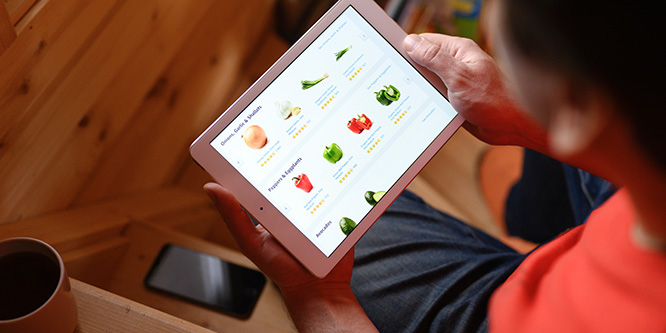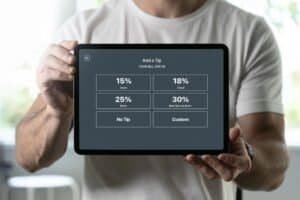
Photo: @ksenia_she via Twenty20
April 14, 2021
Is e-grocery killing or inspiring impulse buys?
Recent surveys are telling different stories about how the consumer adoption of e-grocery during the novel coronavirus pandemic has impacted impulse shopping.
In a study from PowerReviews, 31 percent of shoppers reported that one reason for using e-grocery is to avoid making impulse purchases. A MoneyTalks News article on the study posits that it is easier for customers to stick to a list when grocery shopping online, enabling them to avoid the temptation of seeing attractive, unfamiliar products in-store. Avoiding impulse purchases was the third most popular reason for e-grocery shopping, under personal safety (49 percent) and time savings (59 percent).
A Magid survey from last summer, however, found that a segment of customers reported making more impulse purchases when shopping online. StoreBrands reported on the study, which found 16 percent of respondents fell into this category, making a large number of purchases in snack foods (42 percent) and ice cream/frozen treats (38 percent) categories. Of those customers, 53 percent said they would stick with the products they tried on impulse if given a “buy again” option.
While the question of how much online shopping impacts impulse buying has resurfaced with the unprecedented increase in e-grocery adoption over the past year, it is a question that the industry has asked before. Studies in 2013 pointed to in-store shopping as a far greater source of impulse buys than online, but other studies in the decade before that pointed to more than 40 percent of purchases made online falling under the “impulse buy” category.
These days, in the e-commerce world beyond grocery, businesses have been establishing new ways to incentivize impulse purchases online, such as flash sales. A survey recently found that four in 10 consumers are more likely to purchase a product online if it goes on sale for a limited amount of time, according to The Fintech Times. Customers between the ages of 18 and 34 are the most influenced by such sales, and strategies like “low stock” notifications also push impulse conversions in this cohort.
- This Surprise Factor Is Helping Fuel a Surge in Online Grocery Shopping – Money Talks News
- Survey shows shoppers sticking with private label during pandemic – Storebrands.com
- Openpay Research Finds Retailer “Cart Art” Tactics Influence £3.4billion in Impulse Buys – The Fintech Times
- Is Impulse Shopping Bigger Offline or Online? – RetailWire
Discussion Questions
DISCUSSION QUESTIONS: Do you think Americans are sticking to their grocery shopping lists and avoiding impulse purchases by using e-grocery or are they doing more of it than they’re aware of? How can grocers drive more impulse purchasing online?
Poll
BrainTrust
Paula Rosenblum
Co-founder, RSR Research
Lisa Goller
B2B Content Strategist
Brandon Rael
Strategy & Operations Transformation Leader
Recent Discussions







For the majority of shoppers, I think impulse buying is much lower while shopping online than in-store. With weekly shopping lists that can be saved online and just adding the additional items each week, shopping is more mechanical and there is less time spent exploring unplanned purchases. While in the store, there are lots of opportunities to be tempted by products that catch your eye or your kid’s eye. Remember the days when grocery stores had samples of new products? That was another opportunity for impulse purchases.
What I think doesn’t much matter – there should be real data (not self-reported survey data) on this topic. For example, Kroger knows what volume of impulse items they sold two years ago, last year, and this year and can identify whether a sale came from in-store or online (and could probably split online into BOPIS and delivery). We should see what that data says – people these days will lie through their teeth as a self-image protection measure.
Rod Martin wrote in The Psychology of Humor, “In a study, 94 percent of respondents identified themselves as having an above-average sense of humor.” It is a good reminder to be very wary of what consumers say they want, or what they believe motivates them. Whether it is true that impulse purchases are aided or hindered because of e-grocery remains to be seen. What this survey of one will conclude is my household is growing tired of nonsensical substitutions from well-intentioned professional shoppers and we are looking forward to getting back to store visits for ourselves.
I just know that I don’t stick to the list when I shop for groceries online. I also find that sales drive me to go outside the box. I think grocers need to get more creative in their flash sales (limited offers for the next five minutes creatively presented that match the market basket). Real-time analytics will drive customer behavior if presented in a user-friendly interface with relevant content.
I think impulse buying has to be going down. “Browsing through the store” is more challenging when buying online, and while grocers have taken to presenting “did you forget” items right before checkout, it’s generally not the same as what you see at the checkout stand in a store.
It seems to me that the more these sites use ML for customers who shop with some frequency, the more likely they are to get those impulse buys during the shopping trip.
This stat made me stop in my tracks: “Thirty-one percent of shoppers reported that one reason for using e-grocery is to avoid making impulse purchases.” Retailers must get very creative building the basket AND doing it with the shopper’s interest in mind. Expecting these list-driven shoppers to add something that doesn’t help solve their immediate need state may simply be a wish. I’m eager to see how basket building can be achieved more purposefully.
This really depends on the consumer and how and why they shop online for food. There are also variances by category with treat products more likely to be bought on impulse when shopping online. However, generally speaking, online does suppress some impulse shopping and, interestingly, we have also found that it reduces the tendency to switch brands in some categories. Both are mostly because a lot of online shoppers buy from lists or navigate to items they regularly purchase and are more inclined to ignore other products compared to their counterparts in physical stores.
I think you highlight the bigger challenge for marketers than impulse buying. List shoppers online are less likely to switch brands. The online grocery shopper is keeping the experience simple and convenient, essentially not wanting to make choices or decisions.
Moving online will definitely call for redefining the merchandising strategy for impulse products. Even the role of packaging in the online world will see some changes – why do we need expensive colorful packaging that is primarily designed for attracting customers to pick the product from the shelf? I recently spoke to a company that is making much lower margins on one SKU only because the signature ink they use on the package is very unique and expensive.
I may take some criticism for this, but this is not unlike the difference between shopping for clothing on the Internet and browsing through an attractive printed catalog. My bet is that there is a better chance of the consumer buying an impulse item (something for which I was not looking, but liked it once I saw it). Similarly, there is a better chance of buying an impulse item while strolling the aisles of a supermarket than shopping from a list on the Internet.
Stores’ immersive sensory experience makes impulse purchases more tempting and likely. By contrast e-commerce can make shopping more rational. We may shop by category and focus more on meal planning than on non-essential items.
That said, I have at ten bags of chips in my pantry. (Who among us can resist three for $8?)
Online deals and limited-time offers can work, especially in non-staple categories that we might otherwise neglect while shopping from home.
Generally speaking, I think that shopping online will reduce impulse buys – it’s something I can personally attest to in the way my family buys groceries. Having said that, smaller baskets could be a small price to pay if having a great online platform drives enough frequency and transactions to even out the equation. As with many things, a lot of answers lie in the data where smart retailers can offer high-affinity products to online shoppers or leverage shopper analytics to increase baskets. Another needed consideration is that not all smaller baskets are due to lack of impulse — some could be competitive siphoning that is occurring now that shoppers are able to directly compare groceries at the same time and decide to buy the chips and wine from one retailer and the produce from another to all get delivered on the same day. The impulse buy was still there – it just went to a competitor. Again – the truth lies in the data and having the right competitive analytics can help retailers better understand their basket trends.
Great question. Personally I find my impulse buying drops to almost zero when I use online ordering for groceries. Navigating my shopping list takes all of my attention as I hunt and peck at the items I want. I rarely see suggestions for complimentary items because I’m too focused on getting to the next item and checking out. There certainly are opportunities to drive more impulse purchases in online grocery shopping. I believe they all involve personalization and understanding shopper preferences. A simple one that the grocery where I shop still doesn’t do, and I think is a miss, is to recommend items from previous orders that aren’t on the current order. I would actually appreciate that recommendation since I tend to forget items.
Another is to really understand what items compliment each other. Using big data and market basket analysis this can go beyond the obvious peanut butter and jelly. We’ve been doing this with targeted coupons for years. To take this to the next level, understand what items might be complimentary for the specific shopper based on previous purchases and population attributes from their location.
The real challenge is to present the offers and items in a way that doesn’t make the shopper feel like their ordering process is unnecessarily slowed down by extra suggestions and ads.
Until search, discovery, frequently paired suggestions, and even merchandising (yes, merchandising for grocery!) is improved with robust AI technology then impulse purchases online will lag because the customer is not being shown the right merchandise. I just published an article on this!
You are absolutely right, Christine! Merchandising is not restricted to brick-and-mortar, using effective placement strategy, organization, and taxonomy in a digital space is indeed merchandising. And frankly, I have yet to see an e-commerce site fully taking advantage of this approach.
I remember the good old days (like five years ago), walking through a Whole Foods and seeing a stubbed roman pillar with mounds of chocolate on it. What person in their right mind wouldn’t just grab some of that, especially since you were offered a taste? Those days are over, and the algorithms that give you “if you like this, you’ll like this” just don’t work for grocery impulse yet. Can it get there? Sure, but it’s a long way from mounds of enticing chocolate right now.
I can’t speak to anyone else’s habits, but I am definitely open to impulse buying when shopping for groceries online (which I have done exclusively for the past 13 months, so I now have lots of experience!). What I think is missing is creativity from the grocers to make it more likely for me to add unplanned items to my cart. I just have not seen much effort made to incentivize impulse purchases, and I think there is a great untapped opportunity there. Integrate recipes featuring seasonal produce into my journey. Introduce me to new items and make me an offer I can’t refuse, and I will expand my basket, I promise!
Intuitively it would seem impulse would be higher in-store, especially for food shopping, where all products are visible and those visual cues drive consideration. However without having the data it’s hard to say for sure.
Grocers are already using banners and search terms, especially as they turn their websites into media platforms. Those ad methods likely drive some awareness and convert impulse buys. Over time sites will be even more customized based on past behaviors and insight from other platforms to predict or prescribe items that will undoubtedly drive more impulse.
They might do something like Netflix and have a percentage likelihood a particular food is a match or “these friends gave this product a five star rating.” So more and better integration of familiar tactics from sites people spend time on. LOTS more to do on the e-commerce front.
Online shopping’s impact on impulse buys depends on the usage occasion — impulse buys for future consumption might actually be enhanced but immediate consumption purchases are zero. Will I order a half gallon of ice cream or a 12-pack of soda? Maybe. But will I order a single Dove Bar or a single-serve Coke? Not likely.
There are conveniences, efficiencies, and time savings associated with online grocery shopping. However the art of discovery and impulse shopping is lost, with customers being far more purpose-driven with their e-grocery shopping experiences.
However as the user experience evolves and the e-grocery platforms became hyper-personalized, there may be opportunities to communicate flash deals and other items that the customer may be interested in based on their shopping histories. It will take plenty of machine learning, AI, and a hyper-personalized strategy to get to that point of predicting, responding to, and understanding consumer needs.
I still prefer to do my own grocery shopping where I am almost programmed to make impulse purchases. As a store planner I am acutely aware of how a sales floor is set up to encourage impulse buys and yet I still do it.
I also regularly order groceries via Instacart for an out-of-state family member and I almost never make impulse buys. Sure I may look for additional items she may enjoy, but those additional items require thought, they aren’t added to the cart on impulse. Grocery shopping online is almost an automatic experience: click to find the items on your list and click to buy. Easy, done, over.
It is hard to impulse shop online – I go to buy and then pretty much leave the site when done. Some sites do show you new items on the splash page to consider but it is just not the same as when you are in an actual store.
Online, we are shopping list people. We either put the item we want in the search bar or go to the category (i.e. snacks or ice cream).
The difference in the studies may have to do with the definition of impulse buying. I define an impulse buy as something I had no desire or need to purchase, but I see it on a shelf and think I should try it. I do not define impulse buying as having corn chips on my grocery list and adding pita chips when I get to that shelf or category.
One of the benefits of online grocery shopping is that it is not necessary to shop the entire store (go up and down aisles). The online retailers have structured their sites to accommodate convenience. If they institute anything to encourage the impulse buying experience similar to that of in-store, I believe they will chase away their shoppers.
I share most panelists’ personal experience of more impulse buying inside a grocery store vs. “sticking to the list” when shopping online. There are no feature displays on physical endcaps (although grocers can do a better job simulating this experience online), and no checkout lanes filled with candy and soda.
But Stephen Needel makes a key point: Grocers themselves have more data than we do on the subject. Their ability to mine the data should lead them to modify consumers’ behavior when they are shopping online.
Online shopping just doesn’t lend itself to impulse buying as much as walking through a store with attention-grabbing displays of items on each end-cap or at the checkout counter.
Impulse shopping is undoubtedly different in the online world. However this past year shouldn’t be considered indicative of where things will go in the future. Most people who have used online grocery in the past year plan to continue to use it going forward. But a lot depends on to what degree, and for which products. Many people will likely still use online grocery to load up on essentials but go back to stores more often for their perishables and specialty items. And there is some data to suggest that in a non-pandemic setting people sometimes still run into the store while doing a curbside pickup for last-minute items. So how much impulse buying will really be lost? Some for sure, but its too early to tell.
That said, there is a big opportunity for retailers to think even further “outside the box” with e-commerce platforms. As others mentioned, personalization can play a role. So can recipe inspirations (increasingly being integrated into retailer platforms) that can drive suggested side dishes, etc. Maybe it is a personalized sidebar with products similar to new items the customer has purchased in the past instead of just blitzing this week’s deals. Maybe it is working with CPG partners to add more free samples to online orders to encourage trial in a different way. We’re still at the early stages of grocery e-commerce, with a lot of innovation yet to come.
I see this question as less about impulse or planned purchasing and a consumer’s decision to treat themselves or not.
One of the things we found early on during the pandemic was that simply buying what was on the grocery list was starting to get monotonous. So, we started branching out looking at treat categories online to determine if there were foods from main menu items to different snacks that we would try to supplement what we might seek out at bakeries, restaurants, etc. Similar to just sticking to the grocery list, this too becomes a bit much so shopping has taken on an ebb and flow between frequent treating and little or none at all. Pretty much the same as we were doing when we shopped in stores.
I think this is a really good point to focus on: what has been the use-case of online shopping for the past 13 months, versus what do we expect the reality of post-pandemic online grocery to be?
In a world where online grocery shopping has become the primary form of grocery shopping, there are plenty of people for whom this will only be part of their wallet spend. I can see a future where I would use online for relatively-fungible staples, such as cooking oil, canned goods, and snacks, while using in-store shopping as a treat mechanism: artisanal cheeses, fresh seasonal produce, and breads and pastries.
Does impulse buying groceries play as critical of a role in all futures?
I agree with you George. But I think people are liking the convenience of online shopping more than anything. It’s a priority even more so than saving every dollar.
Impulse buying is driven by exposure, so it’s going to depend on what whatever site someone is using displays (i.e. lot’s of pop-up or sidebars on enticing items, then it might happen). But assuredly less of the traditional types of impulse buys.
The rate of impulse buying would depend on the customer, but with more personalized purchase tracking through e-grocery, retailers can make a better guess at what each customer would be enticed by and also what patterns exist for “impulse” buys at large. This kind of data empowers retailers to run highly targeted promotions or offer in-cart coupons on items that customers may be more likely to purchase.